Images and Ideas in World Art Final Exam
1/28
There's no tags or description
Looks like no tags are added yet.
Name | Mastery | Learn | Test | Matching | Spaced |
|---|
No study sessions yet.
29 Terms
Contour Rivalry
An image that can be viewed in one position and be recognized as one design, then rotated, usually 180*, and appear as something completely different
Horizon Style
In Andean art, a style such as that of the Chavin, Huari, or Inca which is widespread over several regions
Ashlar Masonry
A technique in stone construction where finely dressed stones are laid in a regular pattern without mortar, providing a strong and durable structure.
battered
a sloping base wall
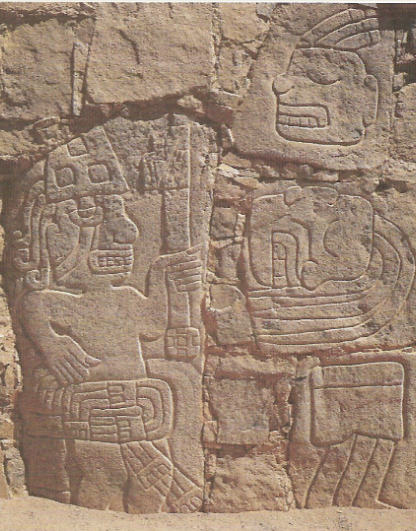
2.2 Cerro Sechin, Stone Relief of a Warrior, c. 2000 BCE
-carved granite monoliths set with clay mortar
-carved with figures who appear to be taking part in rituals that include a victory procession of the military, the sacrifice of captives, and the display of war trophies
-the trophies of war include severed heads, arms, legs, intestines, eyeballs
-blocks are carved in sunken relief, figures formed by sharply incised contour lines
-full figures are rendered in composite view, with head and limbs shown in profile and the torso frontal
-scenes of sacrifice are often set within the confines of a sacred precinct, since theirs are public it suggests a historical narrative rather than a sacred one
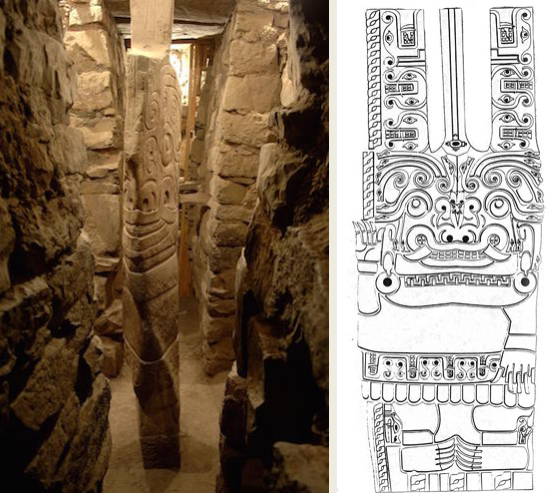
2.4 Chavin de Huantar, Old Temple Lanzón Gallery, Lanzón Monolith, c. 1200 BCE
-unknown name of the divine being that is carved, called “Primary Deity” (Smiling God)
-triangular shaft of white granite, name came from its shape resembling a lance/spearhead
-sits in the center of a chamber only for 2-3 people at a time
-the two long sides of the shaft are carved as the left and right profiles of the being, which then viewed along its narrowest point, merge to create a frontal image
-toothy grin, fangs, wide eyes, serpentine hair, tall headdress with animal heads, pendant earrings, claws w pointy nails
-in between the headdress there’s a carved channel, which may have allowed for a liquid offering to be poured down
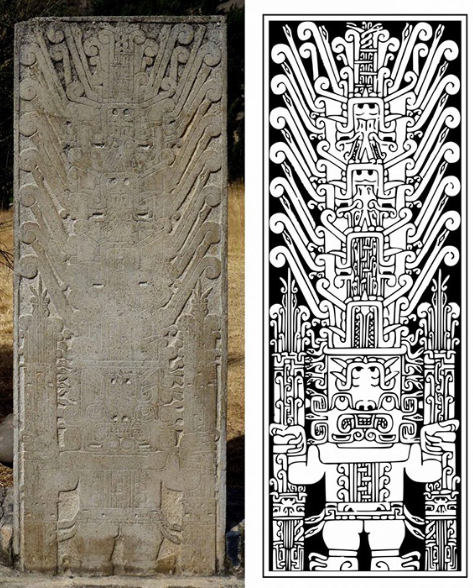
2.6 Chavin de Huantar, Raimondi Stela, c. 900-500 BCE
-named after the Italian-Peruvian archaeologist that found it
-carved into two layers: first carved to appear raised, then more intricate smaller carvings to add detail
-contour rivalry; facing upwards it is a deity, while upside down it is a caiman, which is an alligator-like animal
-Deity wears an elaborate headdress and is holding possibly two flowering San Pedro cactus stems
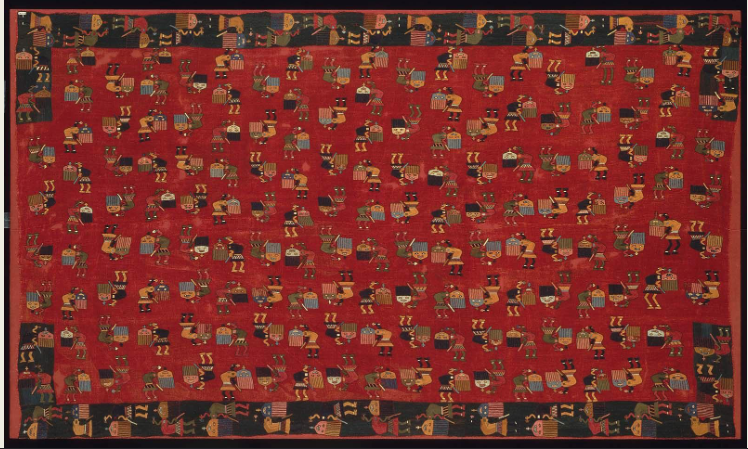
2.7 Paracas, South Coast, Embroidered Mantle, c. 1-100 CE
-included in a mummy bundle, which is when the body is posed in a fetal position, put in a basket, and then wrapped in embroidered textiles
-the textile represents someone’s social status, worn as outer garments in life, and then buried with
-A deep red field w navy borders at the top and bottom; decorated w 180 figures in stem-stitch embroidery
-figures represent a ritual procession of dancers, moving in an up and down movement some turning left some turning right
-wearing face and body paint, pectoral ornaments, short kilts, and embroidered ankle bands, carrying dance wands
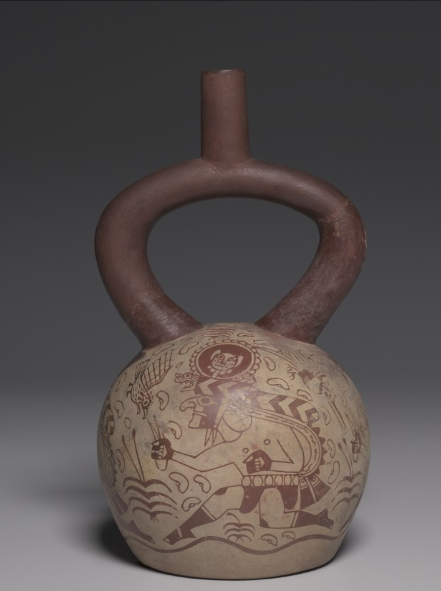
2.16 Moche, Cleveland Painter, Vessel with Running Figures, c. 450-550 CE
fineline: painted with a thin line
-produced in a two-part mold, lower part is called a dumbbell, with a “stirrup” on top, which is hollow
-hard to identify subject, called “ritual runner”, he is running and carrying beans
-the running figures wear short loincloths, held up by ornamented belts, dark stockings with light toes, and elaborate headdresses consisting of feline head and pelts, and gold crests, carrying a bag of beans which are dropping
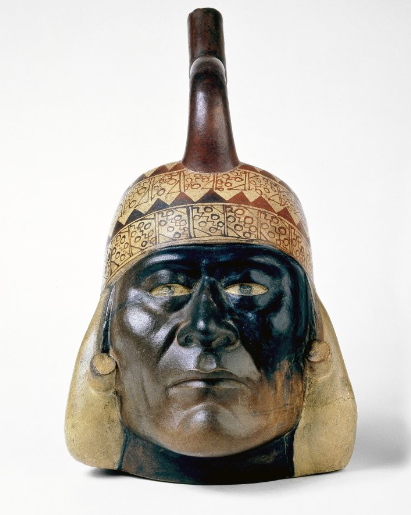
2.17 Moche, Modeled Portrait Vessel, c. 450-550 CE
-high-ranking, middle-aged Moche personage, sensitively modeled to show prominent cheekbones, straight nose, even lips, and a strong jaw, his elite status is shown by his prominent ear spools
-The dark brown color of his face is the result of fire clouding
-multiple copies of the same vessel are produced from the same mold, may have been distributed in elite exchanges

2.21 Tiahuanaco, Kalasasaya Temple, Gateway of the Sun, c. 200 BCE-1000 CE
-might’ve not been its original location; one theory is it was relocated in ancient times and cracked during the move
-monolithic structure
-the front ft. a relief w/ a central image of a Staff God wearing a rayed headdress w/ appendages ending in puma heads and circular beads, body and staffs in low relief and head projects in high relief
-cut into the plain sides of the front are rectangular pockets intended for the attachment of other building blocks
monolith
carved from a single massive block of stone rather than constructed from large individual stones using a post and lintel system
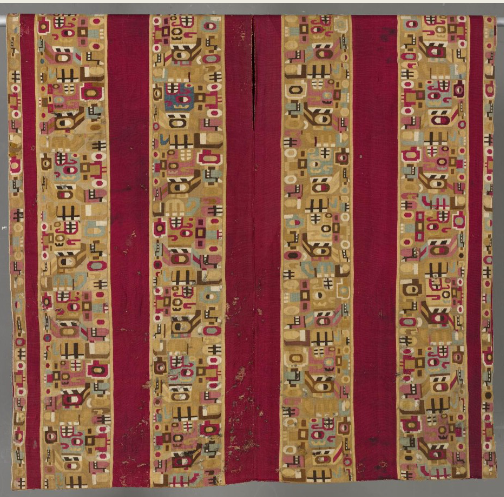
2.22, 2.23 Huari, Sacrificer Tunic, c. 600-1000 CE, camelid and cotton
-the Huari are best known for their exquisite camelid & cotton fiber tapestry weave textiles, signature was the male tunic, constructed from identical panels of cloth, leaving an opening at midpoint for the head and for arms
-this one has complex designs and several colors, so reserved for ritual use by elite individuals

2.24 San Agustin, Colombia, El Purutal, Female with child, c. 100-900 CE
-found in association with large burial mounds that were connected by paths, terraces, and raised causeways; used as sarcophagus covers, tomb markers, and as guardian figures
-carved from tuff and volcanic rock
-supernatural being bc of fanged mouth, head exaggerated in size while the trunk and limbs are compressed
-originally brightly painted
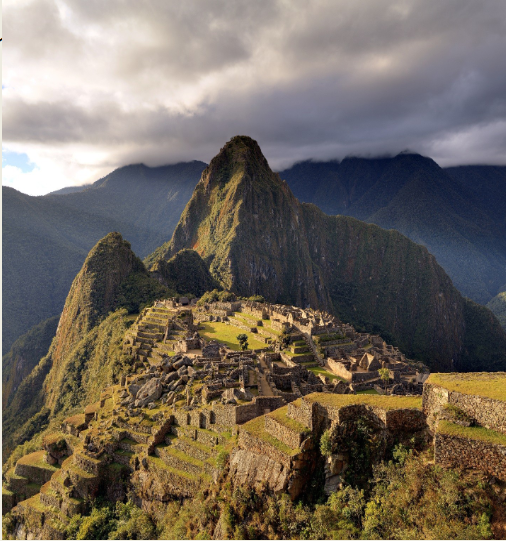
2.27 Inca, Machu Picchu, c. 1450
-the Sapa Inca Pachacuti began building a new royal estate on a narrow ridge between the mountains known as Machu Picchu and Huayna Picchu
-the permanent population of the estate was fairly small, probably fewer than five hundred persons whose job it was to maintain the site and grow crops on the terraced hillsides
-the city was organized around a central plaza and divided into sectors of royal and religious structures and residential neighborhoods, all constructed of local stone
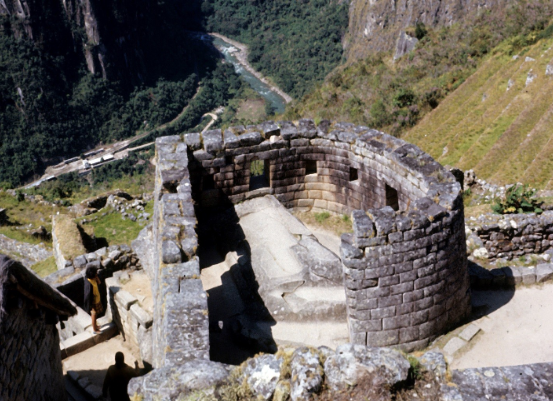
2.28 Inca, Machu Picchu, Torreon or Temple of the Sun, c. 1450 CE.
-a P-shaped building that frames the top of the granite outcrop over which it was built.
-trapezoidal windows frame views of distant mountains considered to be sacred the Inca
-carved a series of steps into the rock
-proposed to be a sun temple or solar observatory for the rising sun on the day of the winter solstice
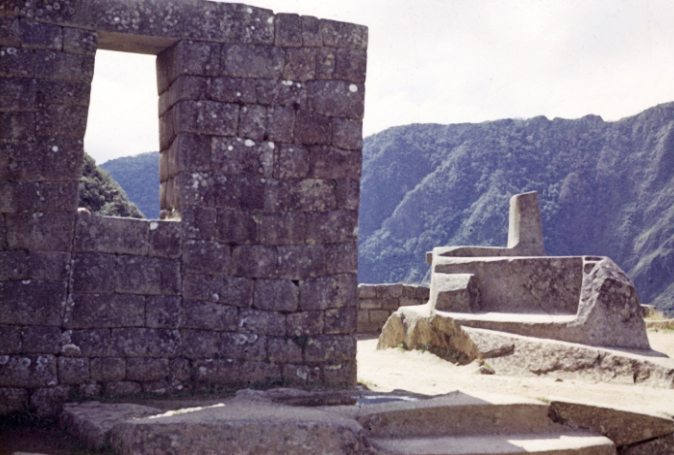
2.29 Inca, Machu Picchu, Intiwatana Pyramid, Intiwatana Stone, c. 1450 CE
-atop the terraced hill known as the pyramid, the highest point of the city, is the carved rock, known as the “hitching-post of the sun”
-known to people as a sundial, which is wrong because its actually echoing the shape of Huayna Picchu behind it

2.35 Colonial Inca Woman’s Anacu or Dress, late 16th century CE
-single length of cloth that was wrapped around the body and secured at the shoulder w/ 2 copper, silver, or gold pins, and cinched w/ belts
-in contrast to male garments, which had vertically oriented and symmetrical decorative patterns, the decorative bands of women’s garments were horizontal and asymmetrical
-the upper ft. floral and faunal motifs and lower is geometric motifs, stylized lions, and blocks of alternating mermaids and women
Caliche
A sedimentary rock composed of calcium carbonate that was mixed with sand and water, and used as natural cement for building by cultures in the Southwest
Effigy mound
Earthworks in the shape of animal or human forms
shamanism
a person regarded as having access to, and influence in, the world of good and evil spirits, typically they enter a trance state during a ritual, and practice divination and healing
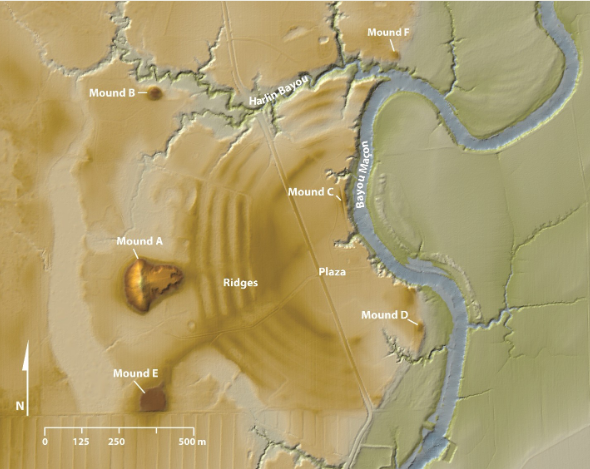
3.2 LIDAR of Poverty Point Site (Mounds and Embankments)
-a 500-acre ceremonial site in West Carroll Parish, Louisiana that seems to have been occupied and built over a period of more than 600 years
-its name derives from the antebellum plantation that occupied the area when the ancient earthworks were first discovered in the 1840s
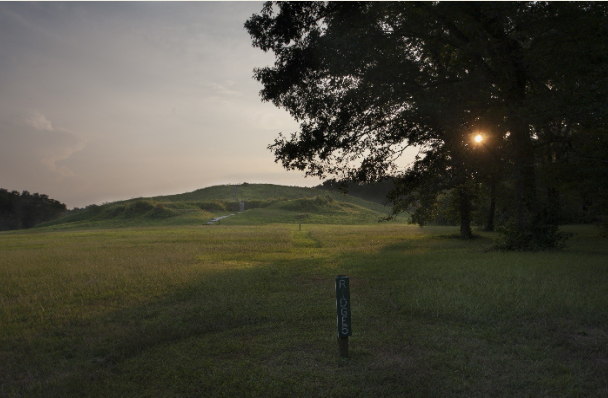
3.3 Poverty Point Bird Mound, c. 1450-1300 BCE
-a T-shaped, two-level pyramid with a long connecting ramp
-the shape of the pyramid and platform is seen by some as a bird in flight
-second largest surviving prehistoric monument in North America
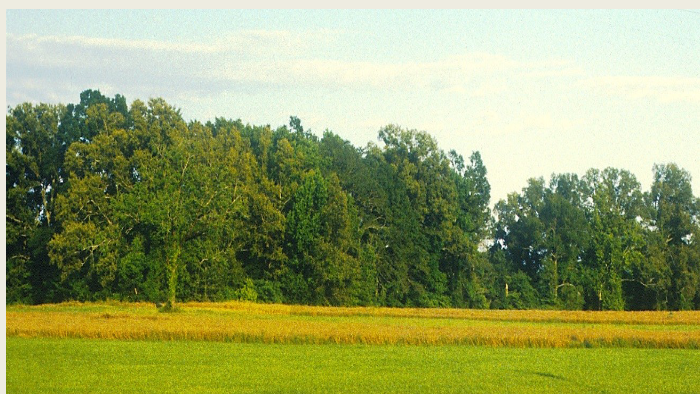
3.4 Poverty Pont Earthworks, detail, embankments
-Construction is thought to have begun around 1700 BCE and may have continued for several generations
-the original heights and widths have been reduced by centuries of agricultural use and by the construction of Louisiana Highway
-may have been residential platforms because fire pits, pottery fragments and figurines have been found
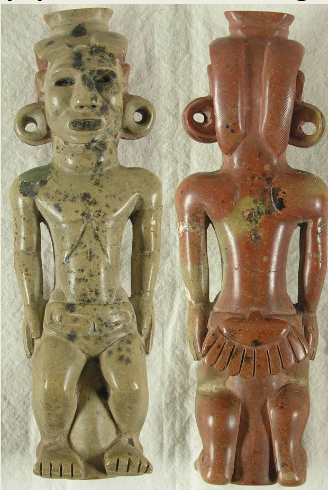
3.6 Adena, Effigy Pipe, c. 100 BCE-40 CE
-found near a buried individual in the Adena Mound
-made of Ohio pipestone
-figure’s upper body is fully in the round, while the slightly flexed legs are in high relief on either side of the pipe tube
-the ribcage, elbows, wrists, fingers, and even nails are indicated
-misidentified as a “dwarf” because many non-western cultures give prominence in scale to the head
-ritual use of tobacco introduced from Mesoamerica
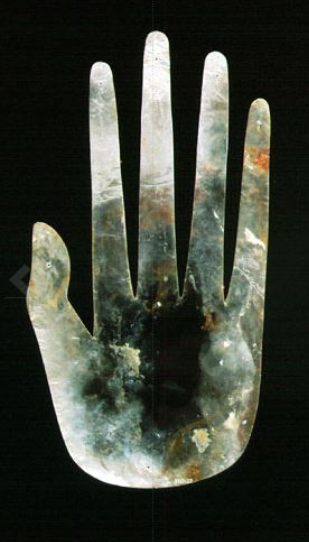
3.9 Hopewell Mound 25, Mica Human Hand, c. 100-400 CE
-four sheet mica cutouts in the form of a hand, a bird’s claw, and two headless human torsos were found at Mound 25
-mica is a translucent mineral that is easily separated into thin sheets, brought in from North Carolina
-funerary offerings for an elite individual
-small holes suggest it may have been attached to a garment
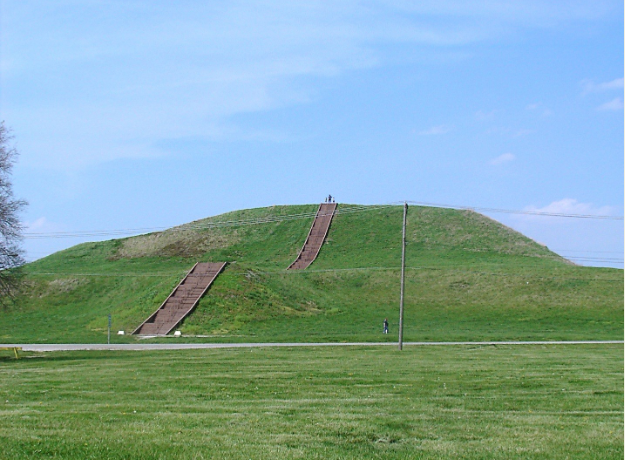
3.11 Cahokia, Monks’ Mound, East St. Louis, IL, c. 950-1200 CE
-a terraced earthen pyramid, largest pyramid north of the Valley of Mexico, named after the monks who used it to grow vegetables in 1809
-earthen ramps on the south and east sides
-built entirely of layers of clays and soils, incorporating layers of limestone cobbles to improve drainage within the structure
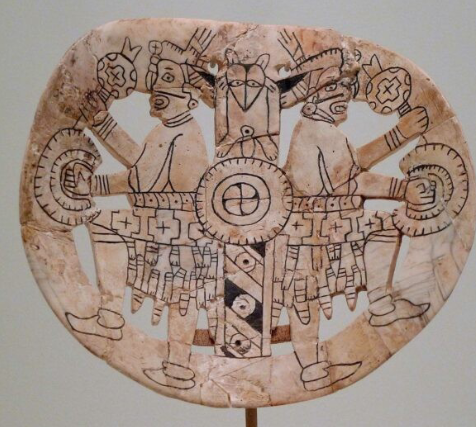
3.14 Spiro, Craig’s Mound, Raccoon Dancers Shell Gorget, c. 1000-1400 CE
-two addorsed (back-to-back) dancers with rattles and circular dance fans stand on either side of a central post
-the post is decorated w/ a raccoon pelt, shell disc, and circular dance fan
-attempted to show space through the overlapping of forms
-Spiro gorgets were cut using stone tools and string saws, using the interior surface of the shell to carved
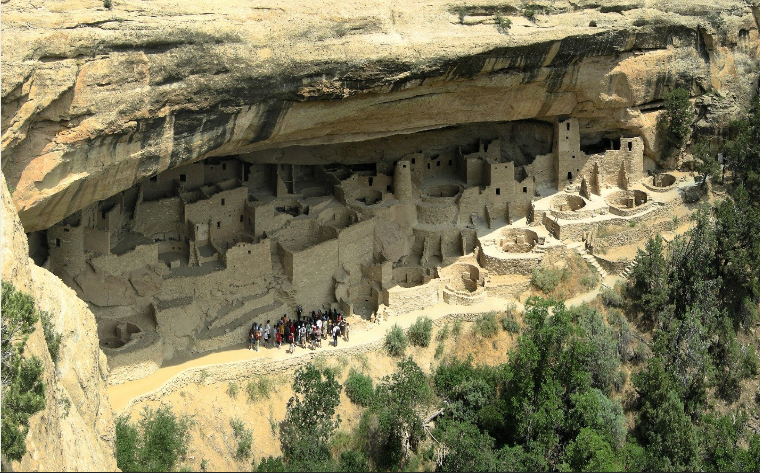
3.16 Ancestral Puebloan, Mesa Verde, CO, Cliff Palace, c. 1190-1260 CE
-city built into an enormous cliff cavity